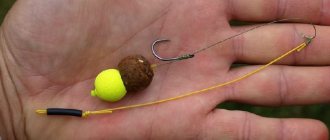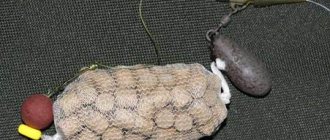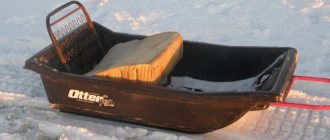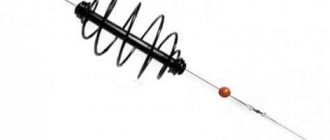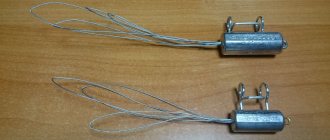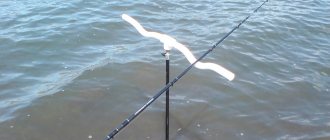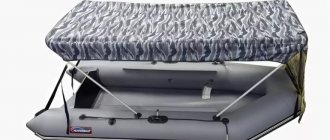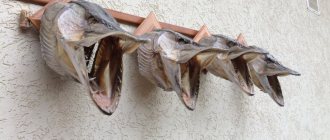Boilies are one of the most popular baits for catching white fish. It is difficult to find a fisherman who has never used them. And this is not surprising. In addition to high efficiency, boilies have a number of advantages that are difficult to dispute. Compared to worms, maggots, and various cereals, this bait is much “cleaner.” It withstands long-distance power casts better, stays on the hook longer, and its large size, in most cases, eliminates the possibility of biting small fish. In addition, they are much easier to store and transport.
Despite the wide variety of ready-made boilies, many fishermen prefer to make them themselves. On the one hand, this is somewhat cheaper, on the other hand, it allows you to choose your own composition for each specific fishing location.
General principles of preparation and basic composition
There are almost more recipes for preparing boilies at home than there are fishermen themselves, however, there are the main components (with certain variations) present in any of them:
- eggs;
- flour (semolina, soybean, corn);
- powdered milk;
- flavorings;
- dyes.
As for the actual production of boilies, it all starts with the mixture. The main requirement is separate pre-mixing. At the first stage, a measured amount of dry ingredients is poured into a large dish, and chicken eggs, liquid dyes and flavors are mixed in a smaller dish. If dry dye is used, it is added to the dish with the dry mixture. After everything is thoroughly shaken and mixed, you can move on to the second stage.
People often argue about what is more correct: pouring the liquid component into the dry one or vice versa. In principle, there is no particular mistake here, the only rule is to add in small batches and mix thoroughly (you can use a fork). And no lumps! When the mixture becomes thick enough, you will have to work with your hands. It is best to wear gloves, otherwise you will have to wash your hands of the dye for a long time. The finished dough should not be stringy, ideally it is dense and easily torn. It must be wrapped in a plastic bag and allowed to stand for about 30-40 minutes.
The next stage is rolling out sausages and rolling boilies. This can be done manually (if you have had to prepare dumplings, then you have the necessary experience) or using special equipment - a board for rolling out sausages, a special syringe, a table for rolling out boilies.
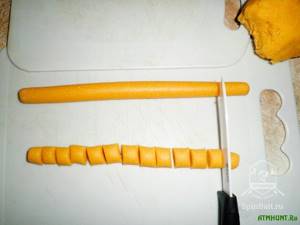
Rolling and cutting boilies
When the boilies are ready, they are placed in a colander and placed in a pan of boiling water. Heat treatment should not exceed two minutes, after which they must be dried for 12-24 hours, spread out on a towel (must be cotton). It is important that the boilies do not touch each other, and that the room is well ventilated. If no preservatives were added to the mixture, you need to store the finished bait in the refrigerator, and if it was added, you can get by with simple bags.

Boiling boilies
Cooking process
Pour all ingredients into a container. When mixing them, add a small amount of water. Stir the resulting dough thoroughly until a homogeneous mass is obtained. Divide it into several parts. They roll into “sausages”. Small pieces come off of them. Try to roll even balls of suitable sizes. There are several cooking options:
- The resulting balls are cooked for 2–3 minutes. Then they dry on a napkin. Try not to let them touch each other. Boiled balls allow you to get sinking bait.
- To make your own floating boilies, the balls are placed in the oven or microwave. They are baked at maximum power. Readiness is determined by appearance. Bring the balls until golden brown. The oven turns off before the dough starts to burn.
- Experienced fishermen increase buoyancy using a bottle cap. It is crushed and added to the total mass. Using a cork will cook the balls.
- A sinking ball is made into a floating one. A small hole is drilled in it, into which a piece of cork is inserted.
Read more
Equipment helicopter and two units for feeder
The more the dough is baked, the better it floats. After cooking, it is recommended to immediately check this indicator. By placing the ball in a glass of water, you will understand how correctly everything was done. A bait thrown into the water quickly floats up. Together with the hook in the water, it is suspended.
Additives and secondary components
These include components that are not essential, but their importance is very great. These are flavorings, food additives and colorings. Aromatic additives can be dry or liquid. Dry, add to the main components with stirring. Their dosage is minimal, from a few grams to a tablespoon per kilogram of mixture. Liquids are plant extracts and dips. They can be added to the liquid component, or they can be sprayed onto boilies before use. They are used in very small doses, 2-7 ml/kg. The main task of flavors is to attract fish from a distance.
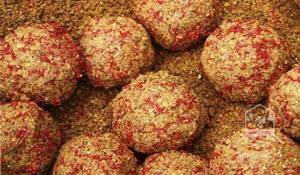
DIY boilies with additives attractive to carp
Secret ingredients of catchy boilies
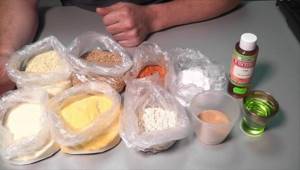
Boilie recipes involve the use of various additional components that affect the performance characteristics of the nozzle:
- dyes;
- thickeners;
- spices;
- spices;
- flavorings;
- other enzymes and food additives.
Secret ingredients allow you to get a bait that best suits the fishing conditions, the time of year, the mood of the fish, and the specifics of the reservoir.
Dyes and thickeners
To give the bait the required color, increasing its effectiveness, just add food coloring of the desired color to it. They are sold in powder, liquid and gel form. As natural remedies, you can use freshly squeezed juice or crushed pulp of various products:
- beets;
- carrots;
- spinach;
- bright berries.
Recommended reading: How to prepare pearl barley for fishing
Important: natural dyes have a smell that fish don’t always like, so you need to be careful when adding them.
To prepare boilie dough, a thickener should be added to its composition. Its role is played by gelatin, starch, pectin, agar. You can use jelly and jelly.
Dry spices and herbs
These ingredients allow you to give the bait the necessary smell and taste. Anglers often use:
- curry;
- ground red and black pepper;
- turmeric;
- ground cinnamon;
- dill seeds, less often anise and fennel.
The listed ingredients should be administered carefully and in small quantities. Otherwise, you can completely ruin the bait, which, instead of attracting fish, will scare it away with its “fragrance”.
Liquid flavors
Spices and spices complement well, allowing you to enhance the smell and make it more persistent. This:
- liquid and jelly-like dips;
- fruit syrups;
- extracts from plants.
They can be added to the dough when kneading and cooking boilies, or you can dip a ready-made bait in them before fishing or immediately before throwing it into the water.
Digestive stimulants
These components are necessary to increase the attractiveness of boilies and stimulate the fish to take action. At the same time, while eating food and boilies, the carp should not quickly become saturated, otherwise it will lose interest in the bait and stop pecking.
Fishermen use the following digestive stimulants:
- betaine;
- ground gammarus and daphnia;
- feed bloodworm;
- crushed sunflower seeds, hemp seeds;
- flaxseed pulp.
To give the boilies a porous, airy structure, you can add crushed table or sea salt to the dough.
Sinking and floating boilies
There is no significant difference in the composition of the ingredients of these two types of boilies. More precisely, it does not exist at all, and the main difference lies in the method of heat treatment. If it is necessary to prepare sinking boilies, they are boiled. If the boilie must have buoyancy, at the last stage it is placed in the microwave.
This method will slightly reduce the effectiveness of flavors (therefore, their quantity should be increased in advance), but this is not the most difficult thing.
The most difficult thing in the process of making floating boilies is to choose the right processing time. To maximize moisture removal, the temperature is set to the maximum, but burning must not be allowed.

Additional drying when making floating boilies
Tip for beginners: set the timer for two minutes, then carefully inspect the boilies. If they begin to char, stop the process immediately. Otherwise, you can turn it on for another 15 seconds and inspect it again. And so on until complete readiness. It is very important to record the time required to process boilies of this particular diameter. There will be no need to experiment in the future.
Hair Accessories for Pop Up
Pop Up is the scientific name for this type of attachment. It is used on hair equipment. The advantages of fishing with floating boilies are undeniable. When a fish bites, it determines how edible the bait is. She is alarmed by everything unnatural. The hair rig allows you to position the hook at a certain distance from the bait. The attractive bait is swallowed, dragging the hook along with it. It is unlikely that you will be able to spit it out.
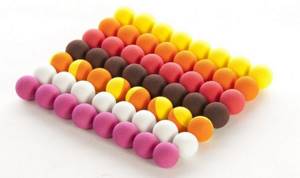
Pop up and Zig rigs
To prepare the hair rig you will need:
- leash up to 20 cm long;
- hook;
- a small piece of silicone tube;
- stopper;
- awl with hook.
Equipment collection process:
- Tie a loop at the end of the leash. It is used to fix the ball.
- The other edge of the fishing line is pulled into the silicone tube. The tube moves closer to the loop. Thread a hook through it and tie it to the fishing line.
- Having pierced the ball with an awl, use its hook to grab the loop on the fishing line, pulling it through the nozzle.
- The stopper will help secure the ball and prevent it from falling off.
- Pierce the nozzle with a needle in several places.
Advantages of hair equipment:
- Manufacturing equipment does not require much time. Even inexperienced fishermen collect it in a matter of minutes right on the pond;
- the bait is located at a certain distance from the hook. When biting, the fish will not detect the hook until it swallows the bait;
- The installation feature prevents the fish from swallowing the hook. He catches his lip. The catch is painlessly removed from the hook.
The equipment will give a positive result if it is assembled correctly. Here, pay attention to the length of the hair. Too short or too long hair causes poor self-cutting. Place the ball from the hook at a distance equal to its diameter.
DIY boilie recipes
Recipe No. 1. Take 400g corn flour, 200g soy flour, 150g semolina. Add 50g of hemp and roasted sunflower seeds. Salt acts as a preservative; about 50g of it is added. The additives and flavors used are 6ml Plum from John Baker, 10ml Protaste Sweetener from Rod Huntchinson and 15ml Betaine Kevin Nash. Everything is thoroughly mixed.
If the price of branded English flavors confuses you or it is difficult to get them, you can use Skopex or Strawberry.
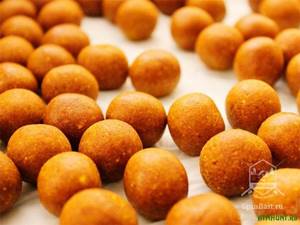
Boilies made according to this recipe have proven themselves well as summer and autumn bait (through mid-September inclusive) for catching carp, carp, and large crucian carp.
Recipe No. 2. Take 200g of milk powder, 200g of fish flour, 300g of semolina, 200g of soy flour and 300g of corn flour, mix. Add five teaspoons of garlic or cinnamon (you can use cumin or coriander) and stir again until smooth. In a separate bowl - five eggs, dyes and liquid flavors of your choice. Mix the contents of both containers, avoiding the appearance of lumps. Roll out the sausages, cut into cubes and form into balls. Cook in boiling water until it floats to the surface, then immediately place on a towel. Dry for at least a week, preferably two.
The resulting boilies are suitable for catching almost all species - carp, bream and crucian carp.

Recipe No. 3. Powdered milk, ground birdseed, wheat, rice and corn flour. Only 100g. The composition of the liquid components, in addition to four eggs, includes dyes, flavors and additives that you prefer.
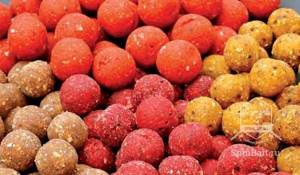
Recipe No. 4. Floating boilies
Five eggs. Powdered milk and ground peas, 80g each. 250g semolina, 150g corn flour and 200g soy flour, as well as 100g ground hemp. Mix all. You can use your choice of flavoring: anise oil, seeds or toasted sunflower oil, chocolate powder, curry, cumin, garlic, cinnamon.
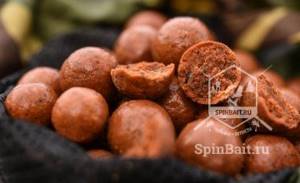
Any dyes, but only light colors. After standard mixing procedures, perform heat treatment in the microwave. Depending on the diameter of the boilies, from 2 to 2.5 minutes.
The dry mixture consists of flour and semolina in equal proportions. Hemp cake and grated potatoes are added - about 30% of each ingredient to the total volume, as well as eggs, flavors, and natural dyes. After processing in the microwave, it is necessary to dry it and carefully pack it in a plastic bag. Before casting, it is better to spray with an attractant.
Floating bait is better visible in the water, and it is aimed mainly at fish feeding in the bottom layer.
If you often have to fish in the same body of water, then experimenting with different flavors and additives, finding the right composition will not be difficult. Whereas ready-made store-bought boilies with certain components may only partially correspond to the preferences of river inhabitants.
How to make boilies
Preparing boilies is a simple process, but it requires some patience. The fisherman must initially decide what exactly he will cook and from what composition. Treats can be buckwheat, soy, wheat or corn.
Next we will talk about the most famous compositions, which you must choose at your own discretion.
First composition:
- Semolina – 150 grams.
- Corn flour – 400 grams.
- Sunflower seeds (roasted) – 50 grams.
- Milk protein (you can buy it at a sports nutrition store).
- Soy flour – 200 grams.
- Hemp – 50 grams.
- Salt (preservative) – 50 grams.
Second composition:
- Soy protein – 300 grams.
- Corn flour – 300 grams.
- Hemp – 25 grams.
- Sunflower seeds (roasted) – 25 grams.
- Salt – 50 grams.
- Milk protein – 250 grams.
- Semolina – 150 grams.

Third line-up:
- Corn flakes or corn flour – 100 grams.
- Ground cake – 300 grams.
- Powdered milk – 200 grams.
- Semolina – 200 grams.
- Soy or soy flour – 200 grams.
Fourth lineup:
- Corn flour – 100 grams.
- Rice flour – 100 grams.
- Bird food (ground) – 100 grams.
- Wheat flour – 100 grams.
- Powdered milk – 100 grams.
Fifth composition:
- Corn flour – 300 grams.
- Semolina – 200 grams.
- Hemp or flax seeds – 300 grams.
- Corn syrup - about 600 grams (no more).
- Buckwheat – 500 grams.
In addition, boilies for catching carp or other fish may also include the following ingredients:
- Puffed rice (it is used only for dusting and floating boilies).
- Coconut flakes (they are also used only for two types of boilies, like puffed rice).
- Fish protein.
- Bran.
- Ground biscuits.
- Ground breadcrumbs.
- Gingerbread or cookies.
- Betaine.

Every angler should know that those compositions that contain protein are intended for catching carp, crucian carp or carp in the cold, when the fish wants to eat and at the same time not spend too much effort on this activity.
Treats with powdered milk make boilies buoyant, so they are best used in the warmer months.
Important! Despite the fact that the most popular recipes for mixtures were presented above, it is better not to copy them exactly, but try to add something of your own.
Experienced fishermen always experiment and then see what comes out of it. Sometimes a fish bites something that, in principle, it should not like, but it eats it with pleasure.
There are fishermen who first purchase ready-made baits, and then, having understood how they work, begin making boilies with their own hands.
